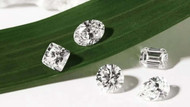How are Lab-Made Diamonds Created?
Sep 30th 2023
The world of diamonds has undergone a remarkable transformation in recent years, thanks to the emergence of lab-made diamonds. These exquisite gems are the product of cutting-edge technology and innovation, providing a sustainable and ethical alternative to their naturally occurring counterparts. In this comprehensive guide, we will delve into the fascinating realm of lab-made diamonds, exploring the intricate processes behind their creation, their indistinguishable qualities from natural diamonds, and the reasons behind their surging popularity. Whether you're a jewelry enthusiast, an environmentally conscious consumer, or simply curious about these remarkable gems, join us as we unravel the secrets of lab-made diamonds.
lab-made diamonds created
Lab-made diamonds are created in a controlled environment using two main methods: high-pressure high temperature (HPHT) and chemical vapor deposition (CVD).
HPHT
Before diving into how lab-made diamonds are created, it is obligatory to discuss the process of UPHT. HPHT diamonds are created by replicating the high-pressure, high-temperature conditions that form diamonds underground in the Earth. A tiny diamond seed is placed in a carbon-rich chamber that is then subjected to pressures of up to 1.5 million pounds per square inch and temperatures of up to 2,700 degrees Fahrenheit. Over time, the carbon will crystallize around the seed, forming a new diamond. Because of the excess sale of lab diamonds, dealers are also compelled to think what is the inspiration behind the design of EX3 Diamond pieces.
CVD
CVD diamonds are created by depositing carbon atoms onto a diamond seed in a vacuum chamber. The chamber is filled with a carbon-rich gas, such as methane, and heated to temperatures of around 1,500 degrees Fahrenheit. Energy from a microwave or laser source is then used to break down the gas molecules, releasing carbon atoms. The carbon atoms then bond to the diamond seed, forming a new diamond layer by layer.
HPHT vs CVD
Both HPHT and CVD diamonds are chemically and physically identical to natural diamonds. They have the same hardness, durability, and optical properties. The only difference is that lab-made diamonds are created in a controlled environment, while natural diamonds are formed over millions of years deep within the Earth.
Why are lab-made diamonds Popular?
Lab-made diamonds are becoming increasingly popular due to their lower cost and ethical sourcing. They are also a sustainable choice, as they do not require the mining of natural diamonds, which can damage the environment and displace local communities. Lab-made diamonds are excessively used for Fashion rings and earrings.
How are lab-made diamonds created?
Pure carbon is pressed in the process of UPHT within a metal cube, and through electronic beats, massive heat and pressure are exposed. Ultimately, the carbon breaks down and crystallizes into a shape. Any metal traces within an HPHT diamond will be minute and generally not visible to the stark-naked eye. Still, several people have questions in their minds about how lab-made diamonds are created due to their increasing demand in society.
How do you know a lab-made diamond is real?
Lab-grown diamonds are equal to Earth-mined diamonds in all aspects, excluding the fact that they are grown in a lab. They have the same biological, physical, and optical properties as mined diamonds. They display similar fire, scintillation, and sparkle. With the rising question of how lab-made diamonds are created, people are also curious to know how they are lab-made diamonds naturally and their specifications.
Time required to make lab-made diamonds
Six to ten weeks are required to develop the lab-grown diamonds in a laboratory. Almost one billion to three point three years ago, diamonds were sufficiently close to the Earth's surface; that's why they are valuable. That is the reason why, before plunging into how lab-made diamonds are created, people first raise the question about the preparation time of lab-made diamonds, and when they know the answer to these questions, they get more satisfied.
Why are lab-made diamonds expensive?
Primarily, lab-grown diamonds are still natural diamonds, and for that reason, they cover a characteristic value reflected in their cost. Additionally, they are classy to cut. Diamonds are so intricate they require particular equipment and very well-trained cutters to produce an adequately cut, beautiful diamond.
Consequently, if you are considering buying a diamond, lab-made diamonds are a great option to consider. They are just as beautiful and durable as natural diamonds, but they are more affordable and ethical.

